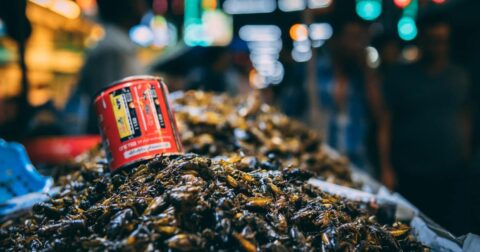Explainer
How Contract Farming Makes Big Corporations Rich And Family Farmers Broke
Food•12 min read
Perspective
The edible insect market is projected to hit $1.2 billion by 2023. But advocates are questioning the motives behind this surprising new trend.

Perspective • Food • Industry

Words by Matilde Nuñez del Prado Alanes
Meat producers have a new animal to farm. In an effort to be more sustainable, the industry is turning to insects as an alternative source of protein. But new research on insect sensitivity and behavior raises ethical questions about this surprising trend.
Humans have fed on insects for centuries and continue to do so today. According to the Food and Agriculture Organization of the United Nations, in 2013, insects were still part of the traditional diet of at least two billion people around the world, mostly in Africa, Latin America, and Asia. Most of the small six-legged land animals consumed for food today are collected from the wild. However, in some countries, insect farms have existed for several decades.
Such is the case in Thailand, where experts estimate there are 20,000 small- to medium-scale cricket farms and about 5,000 for palm weevil larvae, and in China, where there are even some industrial-scale cockroach farms intended mainly for the production of medicines and animal feed. Cambodia, the Lao People’s Democratic Republic, the Democratic Republic of the Congo (DRC), and Kenya also have insect farms, mostly for crickets. Most of these farms are small-scale and not technologically developed.
In the Global North, the insect-based food industry is an emerging sector that is growing rapidly. Until recently, in addition to cultural rejection by potential consumers, one of the main barriers to the growth of the industry was in the legal field, since most Western countries did not have regulations that allowed the marketing of edible insects. However, recently, the EU authorized the use of insects as animal feed, and the United States approved the use of black soldier flies in dog food. Also, Canada allows the marketing of food products based on insects of some species for both human and animal consumption. These initiatives are being replicated in other countries, which creates a favorable legal framework for the growth of the sector.
Canada currently has the largest cricket farm for human consumption in North America, where between 8 and 10 million individuals are harvested each week, in addition to several insect farms whose production is destined to feed for fish, poultry, and pets. One of the world’s largest insect farms was opened in the Netherlands in 2019, and France is also among the leading producers of insects. Meanwhile, the U.S. is projected to produce about 60,000 metric tons of animal feed and 20,000 metric tons of oils for poultry and swine rations per year at the world’s largest insect farm to be constructed in Illinois by 2024.
According to Statista, the global edible insect market could grow from $406 million in 2018 to $1.2 billion by 2023. The projections are so high that even some food industry giants, such as Wilbur Ellis, Cargill Inc., and McDonald’s have thrown their hats in the ring.
In recent years, the insect-based food industry, supported by the FAO, has successfully championed insects as a sustainable source of protein. Insects require much less water and land and emit much fewer greenhouse gases than conventionally farmed animals to produce the same amount of protein. In addition, the industry says it could contribute to reducing food and agricultural waste worldwide. The list of so-called advantages is so long that several prestigious Western media outlets such as the Guardian, Financial Times, National Geographic, BBC, The Times, New Scientist, The New York Times, Netflix & WWF, Wired, and Forbes, among others, celebrate the initiative.
But for insect farming to deliver on these promises, the industry to grow in large magnitudes, which in turn could present some environmental and health problems. In an article published in the journal Trends in Ecology & Evolution, a group of scientists states that “a lack of basic research on almost all aspects of production means the future environmental impact of the mass rearing of insects is largely unknown.”
In their opinion, it is not enough to compare the insect feed-conversion ratios (FCRs) with those of other farmed animals to determine their sustainability. “While it is true that insects may offer significantly better FCRs and a smaller land-use footprint compared to traditional livestock systems, this does not guarantee that the insects-as-food industry will be environmentally friendly,” they state.
In an interview with Reuters, Asa Berggren, a conservation biologist at the Swedish University of Agricultural Sciences and the paper’s co-author, expressed concern about the largely unknown impacts of the mass rearing of insects. “How do you produce the feed they eat, where do you produce it, what do you use?” and “Are we going to use fossil fuels for heating and cooling the facilities (where insects are grown)? What about transportation?” are some of the questions she puts on the table.
Considering that currently, according to the Eurogroup for Animals based on analysis from IPIFF, a group that promotes insects for human consumption and animal feed, “around a third of insect producers use commercial feed which includes soy,” Bergreen’s questions do not seem so out of place.
Others question the possible negative effects of the industry on biodiversity. “For Insect Farming to Work, Scientists Need to Build a Better Bug,” reads one headline. Indeed, for the industry to make enough profit to stay afloat, it needs to reduce production costs as much as possible and, in turn, generate more merchandise. In the case of insect farming, this means they need insects that grow more and in less time. The industry has already put its best scientists to the task, creating genetically modified versions of the insects that are currently being bred the most: mealworms, crickets, and grasshoppers for human food, and black soldier flies, houseflies, and others for animal feed.
“What happens if insects are accidentally released in a country to which they are imported? Insects are tiny and they get out,” says Bergreen. Little is known about the possible impacts of a leak, much less in the case of a leak that involves genetically modified animals. Alarmingly, there is also not much information on the zoonotic diseases that the mass production of new insect species could cause.
Even if insect farming turns out to be more sustainable than raising cows, chickens, and pigs for food, proponents rarely mention the ethical concerns that the industry raises. The research surrounding the sentience, emotions, behavior, intelligence, and other relevant aspects of insects’ lives is quite recent, so the scientific community has yet to come to a consensus in terms of just how much pain and suffering insect farming would cause. However, more and more studies support the idea that many species of insects experience a variety of different emotions.
Andrew B. Barron and Colin Klein, scientists from Macquarie University, consider “insect brains may indeed be capable of ‘phenomenal consciousness’” and have “the capacity to be aware of sensations and emotions.” In a similar path, a recent BBC article mentions that “there’s mounting evidence that insects can experience a remarkable range of feelings” and that they can be “optimistic, cynical, or frightened, and respond to pain just like any mammal would.” According to Jonathan Balcombe, Ph.D. in Ethology and author of the book Super Fly, flies exhibit discerning social lives, idiosyncratic behavior, and sensitivities to stimuli that could be very similar to our own. For example, fruit flies are able to learn from what their peers are doing, they even suffer from insomnia and react to human-effective analgesics for chronic pain in a similar way we do.
“If industry predictions prove accurate, these farms might soon kill upwards of 50 trillion insects a year. That is more insects killed for food in a single year than the number of mammals killed by humans for food in the entire history of civilization,” write Jeff Sebo, director of the Animal Studies M.A. Program at New York University, and Jason Schukraft, senior research manager at think tank Rethink Priorities. In addition, the conditions to which insects are subjected can lead to premature death, as well as cannibalism, which is common among other farmed animals when they are under a lot of stress.
Even if it’s not yet certain that insects are sentient, the latest studies suggest there’s a good chance they are. According to Dr. Steve Cooke, Associate Professor of Political Theory at the University of Leicester, “It is important not to exclude insects from consideration, and perhaps to adopt a precautionary principle given the risks to them of getting it wrong.”
Ethical concerns around the rapid growth of insect farming are growing, in part because producers plan to sell most of the insects as animal feed. According to European Circular Bioeconomy Fund, “growing numbers reveal that most of the insect meal produced will be used for livestock and fish feed.” The fund states that producers are banking on “the market for animal feed as the more immediate business and growth opportunity for the insect industry.” This means that despite the industry’s promise to be more sustainable than traditional animal farming, it will be virtually impossible for it to be more ethical.